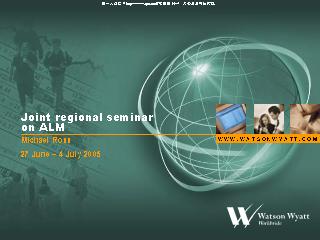Joint regional seminar on ALM(40页).ppt
已下载:1 次 是否免费: 否 上传时间:2012-02-05

Agenda
“Managing management and policyholder behavior”
Why is ALM important
Decision rules and interactions
Implications
Examples
What is Asset Liability Management
ALM is the practice of managing a business so that decisions and actions taken with respect to assets and liabilities are coordinated.
Defined as the ongoing process of formulating, implementing, monitoring and revising strategies related to assets and liabilities in order to achieve an organisation’s financial objectives.
Given the organisation’s risk tolerances and other constraints
ALM is relevant to, and critical for, sound management of the finances of any organisation. Source – SOA Professional Actuarial Specialty Guide: Asset liability management
Thus it is important to get it right
Calculation method – no decision rules
Ordinary projection by policy record
Calculation method – decision rules each step
Step-at-a-time projection for global runs
What are interactions
A typical ALM model will allow for the interactions between the assets and the liabilities
Set of relationships often in terms of a set of decision rules
Examples include
Management behavior
Asset purchases and sales based on projected cashflows from the liabilities
Asset allocation depending on the surplus of the company
Bonus declarations based on the projected level of surplus and /or current yields
Policyholder behavior
Lapse and surrender rates based on economic indicators
Policy loan take-up rates that depend on interest rates from the economic model
Others
Policy expenses that depend on the inflation rate in the economic model
Implications
Why allow for the modelling of these?
Ignoring these items could overstate or understate the results resulting in incorrect management decisions being made.
Example of sensitivity profit testing
Implications
Why allow for the modelling of these?
If looking at capital – then ignoring some of the interactions may result in too much capital or perhaps too little capital.
Can understate the cost of the guarantees
Thus ignoring these effects could well lead to the wrong results being presented to management
Example 1
Book value return
Decision rules – an overview
Balance sheet management
Bonus strategy
Investment strategy
Selection of
assets to
disinvest
Cashflow
Disinvestments
Investments
Policyholder
behaviour
Bonus
Competition
Capital market
Solvency ratio
Capital
Free $
as % of total $
Realisation of
unrealised gain
Solvency requirements
Impact of
Solvency limits
Current solvency
Bonus decision rule
Aim: to declare a stable, competitive and affordable bonus rate
B = bonus rate
i = average market interest rate
Target range for realised return
Budget realised capital gains
Target transfer to the P&L to achieve the budget realised gains
Target transfer to capital
Coverage of the solvency margin

 立即下载
立即下载 立即收藏
立即收藏